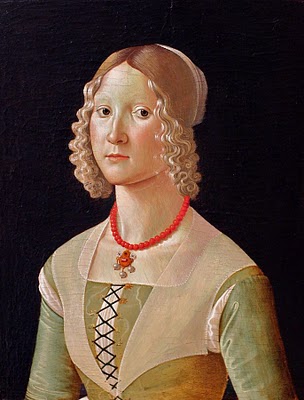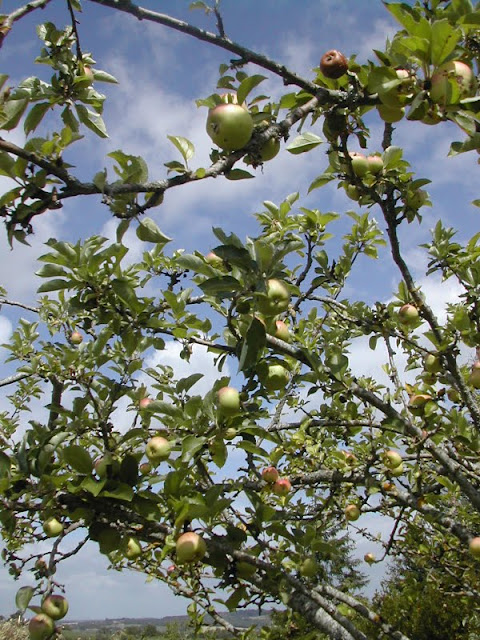"Lady in Yellow"
by Alesso Baldovinetti (1425-1499)
Alesso Baldovinetti's painting depicts the profile view of a lady
with whispy blonde hair set against a bright blue background.
The profile was used for portraits by many painters of the Early Renaissance.
Portrait of a Lady in Yellow, c. 1465 - National Gallery of Art, London
Baldovinetti's representation of a 'lady in yellow' shows the sitter almost to the waist.
Stitched to her sleeve is a pattern of three palm leaves
which is probably not merely a decorative pattern but the emblem of her family
or of one into which she has married, or is soon to marry into.
She wears pearls on her head and around her neck which represents her wealth
and her hair is plucked back which was the fashion of the day.
Alesso Baldovinetti (14 October 1425 - 29 August 1499)
was an Italian early Renaissance painter, born in Florence to a family of a rich merchant.
He was a follower of the group of scientific realists and naturalists in art
which included Andrea del Castagno, Paolo Uccello and Domenico Veneziano.
Tradition says that he assisted in the decorations of the church of S. Egidio,
however, no records confirm this.
In 1462 Alesso was employed to paint the great fresco of the Annunciation
in the cloister of the Annunziata basilica. The remains as we see them give evidence
of the artist's power both of imitating natural detail with minute fidelity and
of spacing his figures in a landscape with a large sense of air and distance;
and they amply verify two separate statements of
Giorgio Vasari - Italian painter, writer, historian and architect
concerning him: that "he delighted in drawing landscapes from nature exactly as they are,
whence we see in his paintings rivers; bridges, rocks, plants, fruits, roads, fields,
cities, exercise grounds, and an infinity of other such things," and that he was an
inveterate experimentalist in technical matters.
His favourite method in wall-painting was to lay in his compositions in fresco
and finish them a secco with a mixture of yolk of egg and liquid varnish.
This, says Vasari, was with the view of protecting the painting from damp;
but in course of time the parts executed with this vehicle scaled away,
so that the great secret he hoped to have discovered turned out a failure.
From 1466-67 date the "Annunciation wall"
in the Cardinal of Portugal Chapel, San Miniato, Florence
The Annunciation is placed over the empty throne that faces the tomb
by 15th century Italian sculptor Antonio Rossellino
The background of cypresses and cedars is painted in fresco,
the wall, bench and figures were painted on oak panel.
The lily in the centre is carved and gilded.
more about Alessio Baldovinetti: here *
Back to Fashion:
Portrait of a Young Girl, 1465
attributed to Domenico Veneziano (1410-1461), alternatively to Alesso Baldovinetti
Baldovinetti's style is marked by the influence of Veneziano,
who was active in Florence from 1439 to 1445.
more about: Domenico Veneziano*
Portrait of a Girl by Domenico Ghirlandaio (1449-1494)
Domenico Ghirlandaio
An Italian Renaissance painter from Florence.
Amongst his many apprentices was Michelangelo
more about:
Domenico Ghirlandaio
by Domenico Ghirlandaio, c. 1490
Portrait of Giovanna Tornabuoni, 1488
by Domenico Ghirlandaio
*
"Lady in Yellow"
Week 26, Diary 2011, National Gallery, London *
Know, first, who you are;
and then adorn yourself accordingly.
Epictetus
An artistic impression of Epictetus
Epictetus (AD 55 - AD 135) was a Greek sage and Stoic philosopher.
He was born a slave at Hicrapolis, Phrygia (present day Pamukkale, Turkey),
and lived in Rome until banishment when he went to Nicopolis in northwestern Greece
where he lived the rest of his life. His teachings were noted down and published
by his pupil Arrian in his Discourses.
Heartfelt and satirical by turns, Epictetus has had significant influence
on the popular moralistic tradition, but he is more than a moralizer;
his lucid resystematization and challenging application of Stoic ethics
qualify him as an important philosopher in his own right.
read more: Stanford Encyclopedia of Philosophyand: The Enchiridion by Epictetus
To Epictetus, all external events are determined by fate, and are thus beyond our control,
but we can accept whatever happens calmly and dispassionately.
Individuals, however, are responsible for their own actions,
which they can examine and control through rigorous self-discipline.
Suffering arises from trying to control what is uncontrollable,
or from neglecting what is within our power.
As part of the universal city that is the universe,
human beings have a duty to care for all fellow humans.
The person who followed these precepts would achieve happiness and peace of mind.
Une tres bonne semaine a tous!


























































































